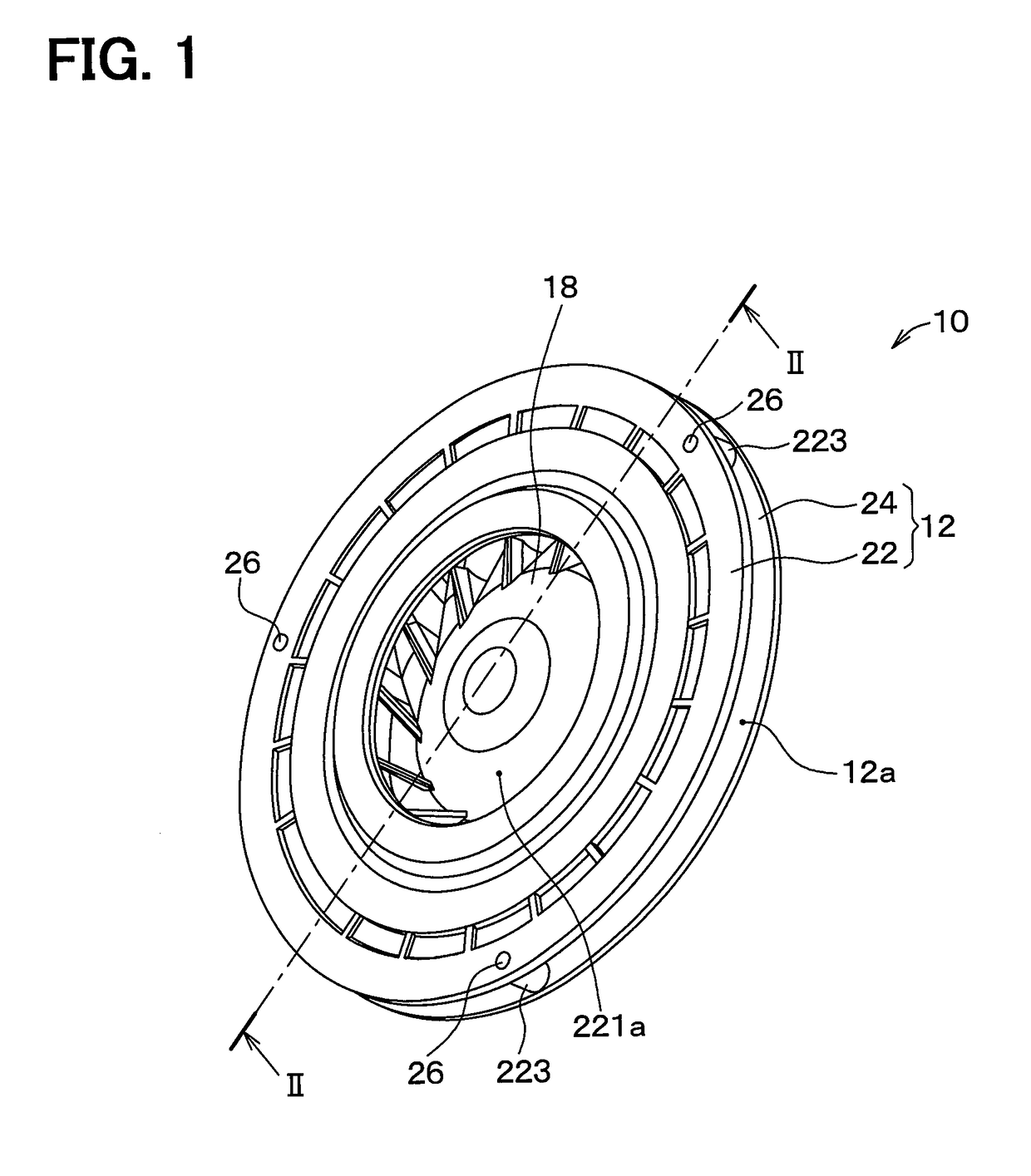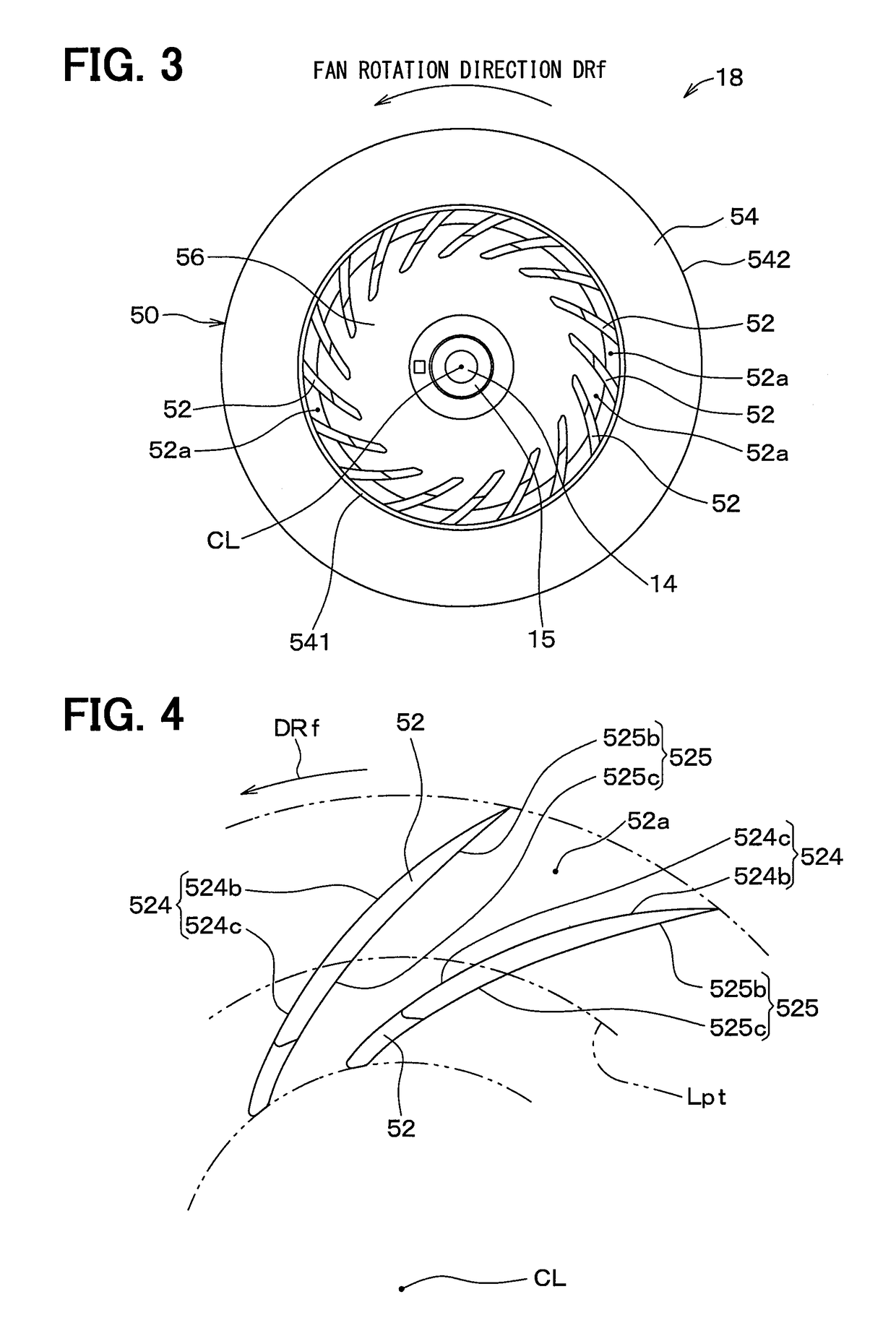Turbofan
a technology of turbofans and rotors, which is applied in the direction of non-positive displacement fluid engines, radial flow pumps, pump components, etc., can solve the problems of minute gap formed between the fan hub portion and the lower side plate, and the performance of the turbofan deterioration, so as to prevent air flow
- Summary
- Abstract
- Description
- Claims
- Application Information
AI Technical Summary
Benefits of technology
Problems solved by technology
Method used
Image
Examples
first embodiment
[0034]FIG. 1 is a perspective view illustrating an appearance of a blower 10 in a first embodiment. In addition, FIG. 2 is an axial cross-sectional view of the blower 10 taken along a plane including a fan axial center CL, that is, a cross-sectional view taken along line II-II of FIG. 1. An arrow DRa in FIG. 2 indicates an axial direction DRa of the fan axial center CL, that is, a fan axial center direction DRa. In addition, an arrow DRr in FIG. 2 indicates a radial direction DRr of the fan axial center CL, that is, a fan radial direction DRr.
[0035]As illustrated in FIGS. 1 and 2, the blower 10 is a centrifugal blower, specifically, a turbo type blower. The blower 10 includes a casing 12, a rotating shaft 14, a rotating shaft housing 15, an electric motor 16, an electronic board 17, a turbofan 18, a bearing 28, a bearing housing 29 and the like which are housings of the blower 10.
[0036]The casing 12 protects the electric motor 16, the electronic board 17, and the turbofan 18 from du...
second embodiment
[0118]Next, a second embodiment will be described. In the present embodiment, points different from the above-described first embodiment will mainly be described. In addition, the same or equivalent parts as those in the above-described embodiment will be omitted or simplified. This also applies to a third and subsequent embodiments which will be described later.
[0119]Even in the present embodiment, similar to the first embodiment, the outflow velocity when the side plate external air passes through the fitting gap 604 of the present embodiment and flows out to the inter-blade flow path 52a, is reduced as compared with a case where the air passes through the reference gap 604z of the comparative example illustrated in FIGS. 7 and 8 and flows out to the inter-blade flow path 52a. However, in the present embodiment, the shape of the fitting gap 604 is different from that of the first embodiment.
[0120]Specifically, as illustrated in FIG. 12, an angle al provided by the side plate incli...
third embodiment
[0125]Next, a third embodiment will be described. In the present embodiment, points different from the above-described first embodiment will mainly be described.
[0126]Even in the present embodiment, similar to the first embodiment, the outflow velocity when the side plate external air passes through the fitting gap 604 of the present embodiment and flows out to the inter-blade flow path 52a, is reduced as compared with a case where the air passes through the reference gap 604z of the comparative example illustrated in FIGS. 7 and 8 and flows out to the inter-blade flow path 52a. However, in the present embodiment, the shape of the fitting gap 604 is different from that of the first embodiment.
[0127]Specifically, as illustrated in FIG. 13, the hub inclined surface 565c and the side plate inclined surface 605c are not provided. Therefore, the diameter of the hub fitting surface 565 does not change at any location in the fan axial center direction DRa. In addition, the diameter of the ...
PUM
 Login to View More
Login to View More Abstract
Description
Claims
Application Information
 Login to View More
Login to View More - R&D
- Intellectual Property
- Life Sciences
- Materials
- Tech Scout
- Unparalleled Data Quality
- Higher Quality Content
- 60% Fewer Hallucinations
Browse by: Latest US Patents, China's latest patents, Technical Efficacy Thesaurus, Application Domain, Technology Topic, Popular Technical Reports.
© 2025 PatSnap. All rights reserved.Legal|Privacy policy|Modern Slavery Act Transparency Statement|Sitemap|About US| Contact US: help@patsnap.com



